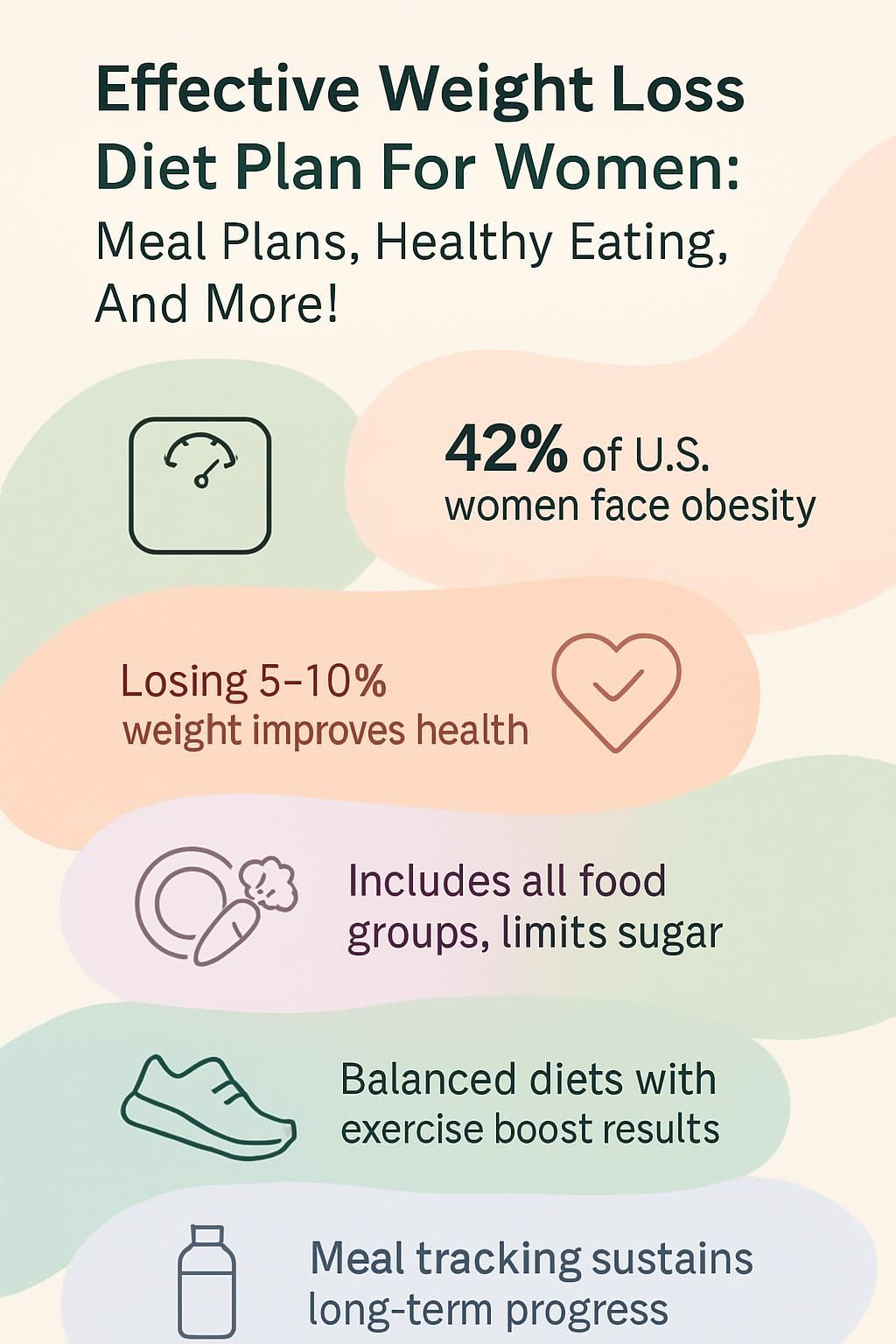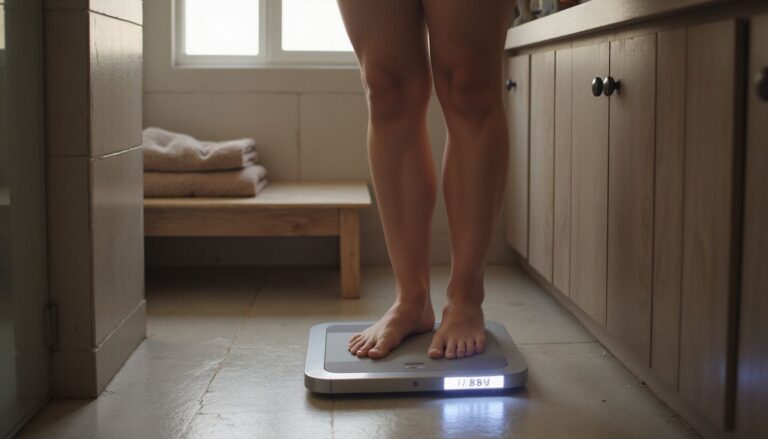Effective Weight Loss Diet Plan For Women: Meal Plans, Healthy Eating, And More!
Our Nutrition Assistant AI Suite will transform your body. You will lose fat, get toned, and build muscle. Gain confidence and optimal health.
Finding a weight loss diet plan for women can feel confusing and exhausting. The choices are endless, and many promise quick fixes. This guide shows you how to build a simple meal plan, choose nutritious foods, and form habits that help you lose weight safely.
About 42% of adult women in the United States live with excess weight or obesity, which raises the risk for type 2 diabetes and heart disease.[1] Here you will learn practical steps based on research, with options you can adjust to your life and budget.
This content is educational and does not replace medical advice. If you have a medical condition, are pregnant, or take medications, speak with your healthcare provider before changing your eating or exercise plan.
…
[1] Centers for Disease Control and Prevention (CDC). “Adult Obesity Facts.” https://www.cdc.gov/obesity/data/adult.html.
Key Takeaways
- About 42% of adult women in the U.S. have excess weight or obesity, which raises the risk of heart disease and type 2 diabetes (CDC, 2023).
- Losing 5% to 10% of your body weight can lower blood pressure and improve cholesterol, which supports heart health (Mayo Clinic).
- Strong diet plans include all food groups, focus on portion sizes, and limit added sugar and saturated fat.
- Balanced meal plans, such as Mediterranean or DASH, paired with regular exercise support steady, healthy weight loss.
- Tracking food and activity increases motivation and helps you build lasting habits guided by evidence-based tips.

Why Are Weight Loss Diet Plans Important for Women?

Clear plans reduce guesswork and help you stay consistent. A thoughtful approach protects your health today and in the years ahead.
What Are the Health Benefits of Maintaining a Healthy Weight?
Reaching and maintaining a healthy weight can lower your risk of type 2 diabetes, heart disease, stroke, and high blood pressure. Research shows that losing even 5% to 10% of your weight improves blood sugar and cholesterol. That small change can have a big impact on long-term health.
A balanced plate with fruits, vegetables, whole grains, lean proteins, and low-fat dairy supports healthy cholesterol levels. Portion sizes matter as much as food choice. Keeping portions in check helps prevent slow weight gain over time.
You may also notice less joint pain, easier movement, and improved energy. Some studies link weight control with lower risk of certain cancers, including breast and colorectal cancer.
How Do Weight Loss Plans Reduce the Risk of Chronic Diseases?
Structured plans help you create a calorie deficit, which means eating fewer calories than you burn. This leads to fat loss and better lab numbers. A diet that is rich in fiber, lean protein, and unsaturated fats supports steady blood sugar and healthier cholesterol.
Even a 5% to 10% weight loss can improve blood pressure and markers of heart health. Choosing whole foods and cutting excess sodium helps your kidneys and blood vessels. Pairing your eating plan with regular physical activity improves metabolism and supports long-term results.
A simple example, building most meals from vegetables, beans, fish, and whole grains encouraged steady progress in my own six-month plan. My energy improved, and my lab results moved in the right direction.
How Can Weight Loss Improve Mental and Emotional Well-Being?
Healthy weight loss often supports mood, confidence, and sleep. Balanced meals stabilize blood sugar, which can reduce irritability and brain fog. Short daily workouts release endorphins, the brain’s feel-good chemicals, which can ease stress.
Small wins fuel motivation. Tracking your first few pounds lost or a week of balanced dinners builds momentum. Better sleep and stable energy also make it easier to stick with your plan.
Key Components of an Effective Weight Loss Diet Plan
Successful plans are simple, flexible, and grounded in science. Aim for steady progress, not perfection.
How to Balance Calorie Intake and Create a Deficit
First, estimate your daily calorie needs based on age, weight, height, and activity level. A calorie deficit means eating fewer calories than you burn. For many women, a 500 to 750 calorie daily deficit leads to about one to two pounds of weight loss per week.
Fill your plate with high fiber foods, such as beans, lentils, vegetables, and whole fruit. Fiber helps you feel full with fewer calories. Measure dressings, oils, and treats since small amounts can add up quickly.
Using a food app can reveal hidden calories from sauces, sweet drinks, and snacks. Choose steady progress over extreme cuts. That approach is safer and easier to maintain.
Why Include All Food Groups in Your Diet?
Each food group offers unique nutrients that your body needs. Fruits and vegetables supply vitamins, minerals, and fiber. Whole grains provide sustained energy. Lean proteins protect muscle. Low-fat dairy adds calcium and protein for bone health.
Skipping a whole group can create gaps that affect energy, mood, and progress. Combine several groups at each meal to support fullness and nutrition while staying within your calorie target.
How Does Portion Control Support Weight Loss?
Portion control limits calories without strict rules. Smaller plates, measuring cups, and checking labels help you serve the right amount. Research suggests that people who watch portions lose more weight than those who do not.
Simple swaps make a difference. For example, use one cup of brown rice instead of filling the plate. Try plain Greek yogurt instead of creamy salads. These small choices add up over weeks and months.
Hydration helps too. Drinking water before or with meals can curb hunger and reduce snacking.
Why Is Staying Hydrated Important for Weight Loss?
Water supports digestion and may raise calorie burn for a short time after drinking. It also helps you tell thirst from hunger, which prevents unplanned snacking. Good hydration makes workouts feel easier, which can help you stay active.
Choose water, sparkling water, or unsweetened tea most of the time. Keep a refillable bottle nearby as a reminder.
What Are Healthy Eating Tips for Weight Loss?
Healthy eating is more than a list of rules. Think of it as a set of simple moves you can repeat each day.
Why Focus on Whole Foods?
Whole foods are minimally processed items like vegetables, fruit, beans, nuts, seeds, eggs, fish, and whole grains. These foods deliver fiber, vitamins, and minerals without extra sugar or sodium. They help you feel satisfied while staying within your calorie goal.
Plan most meals around the base of the food pyramid, which means whole grains, produce, and lean proteins. Use small amounts of healthy fats, such as olive oil or avocado, for flavor. Keep added salt and sugar low to protect heart health.
Building meals around vegetables and low-fat dairy helped me stay full during long workdays. Less snacking made progress easier.
How to Reduce Added Sugars and Processed Foods
Check labels for hidden sugars. Look for words like sucrose, high-fructose corn syrup, dextrose, and fruit juice concentrate. Choose items with less than 5 grams of added sugar per serving when possible.
Drink water or unsweetened beverages instead of soda and sweet tea. Pick simple snacks, such as fruit, nuts, or plain yogurt. Cook more at home using whole ingredients to control salt, sugar, and oils. These steps can lower your risk for conditions related to processed foods.
What Are Healthy Fat Choices?
Choose unsaturated fats from foods like olive oil, avocado, nuts, seeds, and fatty fish such as salmon. These fats support heart health and help your body absorb vitamins, including vitamin D.
Limit saturated fats found in butter, fatty cuts of beef, and full-fat dairy. Swap in oils rich in monounsaturated and polyunsaturated fats for cooking. You need some fat for hormone balance and fullness, so aim for quality, not zero fat.
How to Incorporate Lean Proteins and Fiber-Rich Carbohydrates
Include lean proteins such as skinless chicken, turkey, white fish, salmon, tofu, edamame, lentils, and beans. These foods support muscle repair and keep you full longer.
Choose fiber-rich carbohydrates like oats, quinoa, brown rice, whole wheat bread, and starchy vegetables. Fiber slows digestion and reduces cravings. Combine protein, carbs, and vegetables in meals. For example, pair grilled fish with quinoa and roasted broccoli, or add black beans to a vegetable soup.
Popular Diet Plans for Women
Different diet plans can work. The best plan fits your taste, budget, and schedule.
What Is the Mediterranean Diet?
The Mediterranean diet reflects eating patterns from countries near the Mediterranean Sea, such as Greece and Italy. It highlights vegetables, fruit, whole grains, beans, nuts, seeds, olive oil, and seafood. People eat less red meat, refined grains, and processed foods.
Studies associate this diet with heart benefits and healthy aging. Many people find it flexible and flavorful, which makes it easier to follow long term.
How Does the DASH Diet Work?
DASH stands for Dietary Approaches to Stop Hypertension. It focuses on vegetables, fruit, whole grains, beans, nuts, and low-fat dairy. You limit sodium to support healthy blood pressure, often starting below 2,300 milligrams per day.
Lean proteins like fish and poultry keep you full without adding a lot of saturated fat. Research shows that DASH can lower blood pressure and improve heart health markers. Many women also lose weight because the foods are filling and lower in calories.
What Is Intermittent Fasting?
Intermittent fasting is an eating schedule that alternates between fasting and eating periods. Popular styles include 16:8, which is a 16-hour fast with an 8-hour eating window, and 5:2, which means two very low-calorie days per week.
During fasting hours, water, plain tea, and black coffee are allowed. Studies suggest intermittent fasting may help with weight loss and insulin sensitivity, which is how your body manages blood sugar. Some people prefer timing rules instead of counting calories.
What Are Plant-Based Diets?
Plant-based diets center on foods from plants, including vegetables, fruit, legumes, whole grains, nuts, and seeds. Vegetarian plans may include eggs or dairy. Vegan plans avoid all animal products.
These diets are usually high in fiber and lower in saturated fat, which supports heart health and weight control. A flexitarian plan allows small amounts of animal foods and can be easier to start.
Sample 7-Day Meal Plan for Weight Loss
Use this simple 7-day outline as a guide. Adjust portions to meet your calorie needs and taste.
What Does Day 1 Breakfast, Lunch, and Dinner Look Like?
Breakfast: Oatmeal topped with fresh berries and sliced almonds. Add a boiled egg for extra protein. Drink water or herbal tea.
Lunch: Grilled chicken salad with mixed greens, tomatoes, cucumbers, and chickpeas. Use olive oil and lemon as dressing.
Dinner: Baked salmon with roasted sweet potatoes and steamed broccoli. Season with herbs and a squeeze of lemon. For a plant-based swap, use tofu or lentils.
What Does Day 2 Breakfast, Lunch, and Dinner Include?
Breakfast: Oatmeal with banana and a sprinkle of ground flaxseed. Add a boiled egg for protein.
Lunch: Grilled chicken over mixed greens with cherry tomatoes and cucumber. Drizzle with olive oil vinaigrette. Add half an avocado for healthy fats.
Dinner: Baked salmon served with quinoa and steamed broccoli. Salmon supplies omega-3 fats that support heart health.
What Are the Meals for Day 3?
Breakfast: Greek yogurt with fresh berries and chia seeds. Add water or green tea.
Lunch: Quinoa salad with spinach, cherry tomatoes, chickpeas, and grilled chicken. Dress with olive oil and vinegar.
Dinner: Baked salmon with roasted sweet potatoes and steamed broccoli. Add lemon slices for flavor instead of heavy sauces.
What Are the Meals for Day 4?
Breakfast: Greek yogurt topped with sliced strawberries and chia seeds.
Lunch: Grilled chicken breast with quinoa and steamed broccoli. This combo is filling and nutrient dense.
Dinner: Baked salmon over brown rice with roasted Brussels sprouts. The mix of protein, fiber, and healthy fat supports steady energy.
Snack ideas: Carrot sticks, a small apple, or a handful of almonds.
What Are the Meals for Day 5?
Breakfast: Greek yogurt with sliced strawberries and chia seeds. This pairing brings protein and fiber for morning focus.
Lunch: Grilled chicken with mixed greens, cherry tomatoes, cucumber, and quinoa. Dress with olive oil and lemon juice.
Dinner: Baked salmon with roasted Brussels sprouts and sweet potato wedges. These foods supply fiber, vitamins, and healthy fats.
What Are the Meals for Day 6?
Breakfast: Greek yogurt with strawberries and a light sprinkle of ground flaxseed.
Lunch: Whole grain veggie wrap with spinach, bell pepper, cucumbers, and hummus.
Snack: Baby carrots with a small portion of ranch dip or apple slices.
Dinner: Baked cod with steamed broccoli and roasted sweet potatoes. Simple seasoning keeps sodium in check.
What Are the Meals for Day 7?
Breakfast: Oatmeal topped with sliced strawberries and chia seeds. Add low-fat milk or unsweetened almond milk.
Lunch: Grilled chicken salad with mixed greens, cherry tomatoes, cucumbers, and olive oil. Add half an avocado for healthy fat.
Dinner: Baked salmon with quinoa and steamed broccoli. Quinoa provides complex carbs for lasting energy.
These meals use whole ingredients, lean proteins, and high fiber carbohydrates to support weight loss and daily energy.
How Does Exercise Help with Weight Loss?
Exercise increases calorie burn and helps you keep muscle while you lose fat. It also supports heart health and mood.
Why Combine Diet and Exercise for Best Results?
Food changes create the calorie deficit. Exercise increases the gap. Together, they speed progress and make maintenance easier.
Women who combine both strategies tend to keep weight off longer. Daily walks plus fewer processed foods made my own progress easier to track and sustain.
What Are Effective Workouts for Women?
Mix activities to build fitness and reduce boredom. Aim for a variety across the week.
- Brisk walking, at least 30 minutes a day, supports heart health and weight control.
- Strength training 2 to 3 times weekly with weights, bands, or bodyweight to build lean muscle.
- Yoga or Pilates once or twice a week for flexibility and stress relief.
- Cycling or swimming twice weekly for cardio with less joint strain.
- Short high-intensity interval training, 1 to 2 days weekly, to boost calorie burn in less time.
- Group classes like dance or kickboxing for social support and fun.
- Joining a short online class with friends can make consistency easier.
What Are Common Challenges in Following a Weight Loss Plan?
Most people face hurdles. Planning ahead and simple tools can help you push through tough weeks.
How Can You Overcome Cravings?
Choose fiber-rich snacks like fruit, vegetables, or air-popped popcorn to stay full. Drink a glass of water first since thirst can feel like hunger. Planning meals makes impulsive eating less likely.
Distract yourself for ten minutes, take a quick walk, or call a friend. Keep tempting foods out of reach at home and at work. Practice mindful eating, chew slowly, and notice flavors. That gives your brain time to sense fullness.
How to Manage Time for Meal Prep and Exercise?
Block time on your calendar for shopping, prep, and short workouts. Batch-cook simple proteins and grains on the weekend. Wash and chop produce in advance, then store in clear containers for quick grab-and-go meals.
Use 15 to 20 minute workouts on busy days. Short walks after meals count. Reminders on your phone can help you stay consistent.
How Do You Stay Motivated?
Set small goals you can hit in a week or two, like cooking three dinners at home or walking 8,000 steps per day. Track meals and activity in a journal or app. Progress you can see builds confidence.
Reward milestones with non-food treats, such as a new water bottle or a class you enjoy. Rotate recipes and workouts to keep things fresh.
What Are the Benefits of Tracking Your Weight Loss Progress?
Tracking gives you data you can use. It shows what works, what does not, and where to adjust.
How to Use Food and Activity Trackers Effectively?
Log food and exercise right after you finish. Scan barcodes, search items, or enter simple recipes for accuracy. Review calories, protein, carbs, fats, and hydration daily to spot patterns.
Set reminders so you do not forget entries. Compare weekly results and adjust goals when needed. Tracking helped me find hidden sugars in snacks I assumed were healthy.
How to Set Realistic Weight Loss Goals?
Aim for one to two pounds per week. That pace protects muscle and targets fat. Break big goals into smaller steps, such as cooking healthy dinners five times a week or adding 10 minutes to your daily walk.
Use SMART goals, which are specific, measurable, achievable, relevant, and time-bound. These keep your plan clear and doable.
Why Celebrate Small Milestones?
Small wins add up. Every pound lost, every week of consistent meals, and every workout completed is proof you are moving forward.
Use simple rewards such as a new book, a relaxing bath, or a favorite playlist for your walks. Recognition keeps motivation high during slow weeks.
FAQs About Weight Loss Diet Plans for Women
These answers cover common questions so you can move from ideas to action.
Can I Lose Weight Without Exercise?
Yes. Weight loss comes from a calorie deficit, which you can create with food changes alone. For example, cutting 500 calories a day from meals can lead to about one pound lost per week.
Choose nutrient-dense foods such as vegetables, fruit, lean proteins, and whole grains to feel full on fewer calories. Many people see results by tracking portions and reading labels.
How Many Calories Should I Consume Daily?
Calorie needs vary based on age, activity, height, and current weight. Many women lose weight on 1,200 to 1,500 calories per day. More active or younger women may need 1,800 to 2,000 calories to maintain weight.
A common approach is to eat about 500 fewer calories than you burn each day. This often leads to losing about one pound per week. Consider a nutrition app to spot hidden calories in sweet drinks and large snacks. Talk with your healthcare provider before making large changes.
Summary:
- Weight loss range for many women: 1,200 to 1,500 calories per day.
- Maintenance for moderate activity: around 1,800 to 2,000 calories per day.
- Typical weekly loss target: about one pound with a 500 calorie daily deficit.
- Measure actual portions for best accuracy.
What Should I Do If I Hit a Weight Loss Plateau?
Plateaus are common as your body adapts. Adjust your plan in small ways. Increase workout intensity with short intervals, add strength training twice a week, or move a little more each day.
Track portions closely since most people underestimate intake. Swap sugary drinks for water. Add protein at breakfast to improve fullness. A small change, like choosing eggs and spinach over cereal, helped me break a plateau within ten days.
Conclusion
A steady weight loss diet plan for women relies on simple habits done well. Plan your meals, watch portions, and focus on healthy eating with whole grains, lean proteins, and produce. Pair your meal plan with regular movement to protect strength and mood.
Track what you eat and how you move so you can adjust with confidence. Set realistic goals, celebrate small wins, and be patient with the process. These steps, repeated often, help you lose weight safely and support long-term health.
FAQs
1. What is an effective weight loss diet plan for women?
An effective weight loss eating strategy for women includes balanced meal plans, portion control, and nutrient-rich foods. Research from the Centers for Disease Control and Prevention shows that combining lean proteins, whole grains, fruits, and vegetables supports healthy fat reduction while maintaining energy levels.
2. How do meal plans help with healthy eating during weight loss?
Meal planning helps organize daily food choices to ensure proper nutrition and calorie management. Studies published in the Journal of Nutrition Education indicate that structured menus reduce impulsive snacking and improve adherence to dietary goals.
3. Are there specific nutrients important for women’s health when losing weight?
Yes; calcium, iron, fiber, protein, and vitamins such as B12 are essential during a calorie deficit. According to the National Institutes of Health Dietary Guidelines for Americans 2020-2025 report, these nutrients support bone strength and metabolic function while promoting satiety.
4. Can you share a personal experience or tip related to successful dieting?
After following a planned menu with regular meals rich in vegetables and lean meats over several months I noticed improved energy levels along with gradual fat reduction confirmed by weekly weigh-ins. Tracking progress using a journal helped maintain motivation throughout the process.
Summary: Effective strategies include balanced meal planning focused on key nutrients like protein and fiber; evidence suggests this approach improves results when paired with consistent tracking methods such as journaling or scheduled check-ins.







